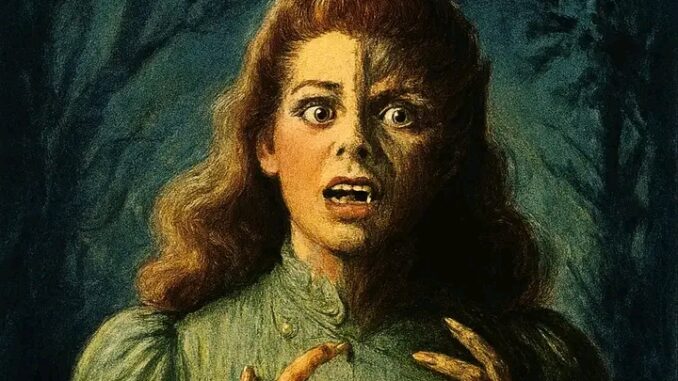
She-Wolf of London Unleashed — The Fearless Beast Within Haunts, Hunts, and Redefines Classic Horror Forever
In the dark, misty corners of horror cinema, certain legends refuse to die. Among them, She-Wolf of London stands as a captivating symbol of transformation, fear, and empowerment — a tale that transcends its time and continues to intrigue audiences decades after its debut. First released in 1946 under the Universal Pictures banner, She-Wolf of London was more than just another monster movie. It was a psychological and emotional study of repression, superstition, and identity — all wrapped in the fog of gothic suspense. Today, it remains a fascinating entry in the Universal horror canon, one that dared to explore the human condition behind the myth of the beast.
At its core, She-Wolf of London tells the story of Phyllis Allenby, portrayed by the graceful June Lockhart, a young woman living in Victorian London who begins to believe that she may be responsible for a series of brutal killings. The mystery deepens as whispers spread of a “she-wolf” roaming the city streets at night. Phyllis’s sanity begins to crumble under the weight of fear, guilt, and manipulation, as she is haunted by the possibility that she might be cursed with lycanthropy — doomed to transform into a murderous creature under the moonlight.
Unlike many of its monster movie contemporaries, She-Wolf of London takes a subtler, more psychological approach. Instead of relying on overt transformation scenes or terrifying makeup effects, the film’s horror lies in suggestion, suspense, and paranoia. It is a rare example of restraint in a genre that often leaned on spectacle. Director Jean Yarbrough crafts tension through atmosphere rather than gore, allowing the audience’s imagination to conjure the true terror. The film becomes a study in how fear can be weaponized — both by the mind and by those who seek to control others through deception.
June Lockhart’s performance is a cornerstone of the film’s power. Long before she became a beloved television icon in Lassie and Lost in Space, Lockhart showcased her emotional depth and vulnerability here. Her portrayal of Phyllis captures a woman torn between rationality and hysteria, between her belief in the supernatural and her desperate hope that she is not the monster others suspect her to be. Through Lockhart’s nuanced expressions and trembling voice, we witness the torment of someone losing grip on reality — and it is in that psychological unraveling that She-Wolf of London finds its true bite.
What also sets the film apart is its underlying commentary on gender and control. In many ways, She-Wolf of London reflects the social anxieties of its era, when women were often seen as fragile beings susceptible to hysteria and manipulation. The “curse” becomes a metaphor for the ways in which patriarchal and societal structures sought to confine women within certain behavioral expectations. Phyllis’s supposed lycanthropy — the fear that she might unleash an uncontrollable, animalistic side — mirrors the broader fear of female autonomy and passion. It is not merely a horror story; it is a psychological reflection of how women’s independence was historically portrayed as something dangerous, even monstrous.
Cinematically, the film’s atmosphere plays a major role in its enduring charm. The fog-drenched London streets, the eerie stillness of Allenby Mansion, and the gothic elegance of the sets create a sense of isolation and dread. The cinematography by Maury Gertsman bathes each frame in shadow, evoking both the elegance of period drama and the tension of noir thrillers. The result is a haunting visual style that feels both romantic and sinister — a perfect reflection of the film’s dual themes of love and fear.
Though critics at the time offered mixed reviews, with some calling it more mystery than horror, She-Wolf of London has since found appreciation among classic film enthusiasts. Its restrained storytelling, intelligent script, and feminist subtext make it a standout in the Universal catalogue. Unlike the tragic male werewolves of cinema — cursed by fate or bitten by another creature — Phyllis’s “curse” is entirely man-made, rooted in deceit and manipulation. That twist gives the film its moral edge: the real monsters are not supernatural beings, but those who exploit fear for control.
Over the years, the film’s influence has subtly lingered in popular culture. Its themes of psychological manipulation and female repression can be traced in later works like Cat People (1942), The Innocents (1961), and even modern reinterpretations like Ginger Snaps (2000), where the “female werewolf” becomes a metaphor for adolescence, identity, and liberation. She-Wolf of London was ahead of its time in blending horror with social commentary, paving the way for a new kind of monster narrative — one that explores the human psyche as much as the supernatural.
Today, nearly eighty years after its release, She-Wolf of London endures not for its jump scares or bloodshed, but for its subtle intelligence. It stands as a haunting exploration of how fear — whether of the unknown, of oneself, or of societal judgment — can transform people into something unrecognizable. The “beast within” may not always have claws and fangs; sometimes, it hides behind polite smiles, whispered rumors, and quiet cruelty.
In the grand tapestry of classic horror, She-Wolf of London is a gem of quiet menace and emotional power. It is a story that reminds us that monsters are often made, not born — and that the scariest transformations happen not under the full moon, but within the human heart.
Leave a Reply